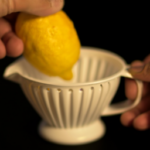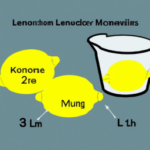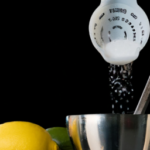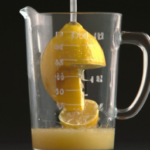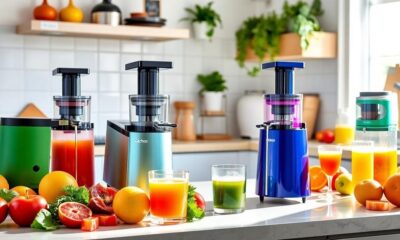Juice Tips and Tricks
How Much Juice In 1/2 A Lemon

As a cooking and baking enthusiast, I frequently need just a dab of lemon juice to perfect my dishes. But, when I squeeze a whole lemon, I usually get more juice than necessary and the leftovers just go to waste.
That’s why I started wondering, how much juice is actually in half a lemon? After doing some research and experimenting in my own kitchen, I’ve learned a few tricks for getting the most juice out of a lemon half and measuring it accurately.
In this article, I’ll share my findings and tips for preparing, juicing, and storing lemon juice, as well as some recipe ideas and alternative citrus fruits to use in place of lemons. Whether you’re a seasoned chef or just starting to experiment in the kitchen, understanding how much juice you can expect from a single lemon half is a useful skill to have.
Key Takeaways
- The average yield for half a lemon is 1-2 tablespoons of juice, but factors like size and ripeness can affect the yield.
- Choosing a ripe and juicy lemon and using a citrus juicer can increase the yield of lemon juice.
- Larger lemons and Meyer lemons produce more juice, while ripe lemons yield more juice than unripe ones.
- Other citrus fruits like limes, oranges, and grapefruits can also be used for their juice and have unique flavors and nutritional benefits.
Tools You’ll Need
You’ll need a few basic tools to get started, like a juicer or citrus reamer, to extract all the juice from half a lemon. Juice extraction can be a bit tricky if you don’t have the right tools.
A lemon squeezer is a great investment if you plan on using lemons frequently in your cooking. It’s a handheld tool that extracts the juice by pressing down on the lemon half. A citrus reamer is another option, and it works by twisting the lemon half on the reamer to extract the juice. Whichever tool you choose, make sure it’s sturdy and comfortable to hold.
Once you have your tools, it’s time to prepare the lemon. Cut the lemon in half using a sharp knife and remove any seeds that may be present. To get the most juice out of the lemon, it’s best to let it sit at room temperature for a few minutes. This will make it easier to extract the juice.
With your lemon squeezer or citrus reamer, press down firmly and twist the tool to extract all the juice from the lemon half. Now you’re ready to use the fresh lemon juice in your recipe!
How to Prepare the Lemon
First, slice the sour citrus, separating the sections from the seeds. There are different ways to slice a lemon depending on the recipe. For example, when making lemonade, the lemon should be sliced crosswise to expose the maximum amount of juice. Meanwhile, when using lemon as a garnish, it is best to slice it lengthwise into thin rounds. Slicing the lemon correctly is crucial because it affects both the amount of juice extracted and the overall presentation of the dish.
Using fresh lemon juice has many benefits. Firstly, it contains more vitamins and minerals than bottled lemon juice. This makes it a healthier option for cooking and baking. Additionally, fresh lemon juice has a more vibrant taste compared to bottled ones. It adds a tangy and refreshing flavor to dishes that bottled lemon juice cannot replicate. By using fresh lemon juice, you can elevate the taste of your dish and make it more enjoyable.
To get the most juice out of a lemon, there are several steps you can take. But first, you need to prepare the lemon by slicing it correctly.
How to Get the Most Juice
When slicing the citrus, aim for thinner sections as they’re easier to juice and will yield a greater amount of the tangy elixir.
There are a few juicing techniques that can help maximize yield and ensure you get the most juice out of your half lemon. Roll the lemon on the counter before cutting it to help break down the cells inside the fruit, making it easier to extract the juice. Cut off the ends of the lemon to expose the flesh, which will make it easier to squeeze out the juice.
Use a juicer or citrus press to extract the juice, as these tools are designed to get the most juice out of the fruit. If you don’t have a juicer or press, use a fork or citrus reamer to manually squeeze the juice out of the lemon.
By following these juicing techniques, you can ensure that you’re getting the most juice possible out of your half lemon. Now that you’ve extracted the juice, the next step is measuring it accurately.
How to Measure the Juice
Measuring the tangy elixir is a crucial step in preparing any recipe that calls for citrus. To achieve measuring accuracy, it’s important to first cut the lemon in half and then use a citrus juicer to extract the juice. This will allow you to collect all of the juice and avoid any potential seeds or pulp.
If you don’t have a juicer, you can also use your hands to squeeze the lemon half over a fine mesh strainer to catch any unwanted bits. It’s also important to adjust for the juiciness of the lemon. Some lemons are juicier than others, so it’s always a good idea to have extra lemons on hand just in case.
If you find that your lemon is particularly juicy, you may need to use less than half to achieve the desired amount of juice. On the other hand, if your lemon is less juicy, you may need to use the juice from an additional half to get the right amount. With a little practice, you’ll be able to measure the perfect amount of lemon juice every time.
Now, onto tips for storing leftover juice.
Tips for Storing Leftover Juice
When I have leftover juice, I always make sure to store it properly to prevent spoilage and waste. One of the best ways to do this is to refrigerate it in an airtight container, which helps to maintain its freshness and flavor.
Another option is to freeze the juice in ice cube trays, which allows for easy portioning and long-term storage. Regardless of the method chosen, it’s important to use the juice within a few days to ensure its quality.
Refrigerate in an Airtight Container
To keep your leftover lemon juice fresh, store it in an airtight container in the refrigerator. This is especially important if you plan on using the juice for DIY lemon cleaning solutions or other recipes.
Lemon juice can be used for a variety of purposes, such as adding flavor to dishes, making salad dressings, or even as a natural cleaner. By storing it properly, you can ensure that it remains fresh and ready to use whenever you need it.
When storing leftover lemon juice, it’s important to use an airtight container to prevent air and moisture from getting in. This will help to preserve the flavor and quality of the juice for a longer period of time. Additionally, refrigerating the juice will slow down the oxidation process, which can cause it to spoil faster.
Once you have stored your lemon juice in an airtight container and refrigerated it, you can then move on to the next step of freezing it in ice cube trays for later use.
Freeze in Ice Cube Trays
Now it’s time to pop those citrus cubes into your drink or recipe to add a zesty touch of flavor. Freezing lemon juice in ice cube trays is a great way to ensure you always have fresh lemon juice on hand.
Here are some creative recipes you can try with your lemon juice cubes:
- Add a cube to a glass of water for a refreshing drink.
- Use in marinades for chicken or fish to add a tangy flavor.
- Mix with olive oil, garlic, and herbs for a homemade salad dressing.
In addition to being a convenient ingredient for cooking and drinks, there are also health benefits to freezing lemon juice. Lemons are high in vitamin C, which is important for immune system function and skin health. By freezing lemon juice, you can preserve its nutritional value for longer periods of time.
Just remember to use your lemon juice cubes within a few days after removing them from the freezer. This will ensure the best flavor and nutritional value for your recipes.
Use Within a Few Days
Make sure you use those lemon juice cubes within a few days to get the most out of their tangy flavor and nutritional benefits. While freezing the juice is a great way to preserve it for future use, it’s important to use it as soon as possible to harness its full potential.
Fresh lemon juice adds a zesty kick to any dish, and can be used in a variety of ways to enhance the flavor of your favorite recipes. If you have leftover juice from a freshly squeezed lemon, there are plenty of ways to use it up before it goes bad. Add it to a salad dressing for a burst of acidity, mix it into a marinade to tenderize meat, or stir it into a cocktail for a refreshing twist.
The benefits of using fresh lemon juice in cooking are numerous, including improved digestion, increased vitamin C intake, and a boost in immune function. So, don’t let that juice go to waste – find creative ways to incorporate it into your meals and reap the rewards.
When it comes to cooking with lemon juice, one question that often arises is how much juice is in half a lemon? The answer may surprise you, as it can vary depending on the size and juiciness of the lemon in question. But don’t worry, we’ll delve into this topic in the next section and provide you with all the information you need to start squeezing the perfect amount of juice every time.
How Much Juice is in Half a Lemon?
When I’m cooking or making a drink that requires lemon juice, I often wonder how much juice is in half a lemon. The average yield for half a lemon is typically around 1-2 tablespoons, but factors such as the size and ripeness of the lemon can affect the amount of juice produced.
It’s important to keep these factors in mind when measuring lemon juice for recipes to ensure accurate and consistent results.
Average Yield
On average, you’ll get about 1 tablespoon of juice from half a lemon. Of course, this is just an estimate and the actual yield may vary depending on certain factors. However, maximizing yield is important not just for the sake of getting more juice but also to make the most out of the lemon juice benefits.
To get the most juice out of a lemon, it’s important to choose a ripe and juicy one. Roll the lemon on a hard surface before cutting it in half to help release the juices. Squeezing the lemon with your hand or using a citrus juicer can help extract more juice. Additionally, microwaving the lemon for a few seconds or soaking it in warm water before juicing can also help increase the yield.
Factors that affect yield include the size and type of lemon, the temperature, and the method of juicing. By being mindful of these factors and using the right techniques, you can maximize the amount of juice you get from each lemon.
Factors That Affect Yield
Just like the weather affects the growth of plants, various factors such as size, type, temperature, and juicing method impact the yield of a lemon.
When it comes to size, larger lemons typically produce more juice than smaller ones. Additionally, the type of lemon can also affect its yield. Meyer lemons, for example, have a sweeter taste and higher juice content than Eureka or Lisbon lemons.
Temperature also plays a role in lemon yield. Lemons stored at room temperature yield more juice than those stored in the refrigerator. Lastly, the juicing method used can impact the amount of juice obtained from half a lemon. Hand squeezing typically yields less juice than using a juicer or reamer. These factors affecting citrus acidity can make a significant impact on the amount of juice that can be extracted from half a lemon.
Additionally, the ripeness of the lemon can also have an impact on its juice yield. Ripe lemons are juicier and yield more juice compared to unripe ones.
Moving on to the next section about alternative citrus fruits, there are other options aside from lemons that can be used for juice extraction.
Alternative Citrus Fruits
When it comes to citrus fruits, lemons are undoubtedly a staple in my kitchen. However, there are many other options to explore when it comes to adding a citrusy twist to my dishes.
Limes, for instance, have a slightly sweeter taste than lemons and can be used to add a tangy flavor to marinades and dressings.
Oranges, on the other hand, have a refreshing sweetness that can elevate anything from salads to desserts.
And let’s not forget about grapefruits, which add a slightly bitter taste that pairs well with savory dishes.
Lime
Imagine yourself holding a juicy lime in your hand, wondering how much juice you can get out of it to add a tangy twist to your favorite dish. Lime is a versatile citrus fruit that has a unique flavor and aroma. It is widely used in various cuisines around the world and adds a refreshing taste to a variety of dishes. Lime juice is also a popular ingredient in cocktails, marinades, and dressings.
To determine the amount of juice in a lime, it is essential to choose a ripe and juicy fruit. A medium-sized lime can yield around two tablespoons of juice, which is equivalent to the juice of half a lemon. Lime juice is rich in vitamin C and antioxidants, making it a healthy addition to your diet. It is also known to aid in digestion, boost immunity, and improve skin health. There are numerous lime recipes that you can try, from lime-cilantro rice to grilled lime chicken. Incorporating lime into your diet not only adds a zesty flavor but also provides several health benefits.
As we move on to the next section about ‘orange’, you may wonder how this citrus fruit compares to lime in terms of its health benefits and culinary uses.
Orange
Orange is a popular citrus fruit that is known for its sweet and tangy flavor. Its juice is a common ingredient in many dishes, desserts, and drinks. Compared to lemon and lime, oranges yield more juice per fruit. Half a medium-sized orange can produce around 1/4 cup of juice, which is almost twice the amount of juice that can be extracted from half a lemon.
Aside from its delicious taste, oranges are also packed with nutrients that offer various health benefits. They’re high in vitamin C, which helps boost the immune system and protect the body against infections. Oranges also contain folate, potassium, and fiber, which promote heart health, regulate blood pressure, and aid digestion. Incorporating oranges into your diet can help you maintain a healthy lifestyle and prevent chronic diseases.
Moving on to the next citrus fruit, grapefruit is also a great source of vitamins and minerals.
Grapefruit
Grapefruit is a tangy and refreshing citrus fruit packed with nutrients that offer various health benefits. One of the most notable benefits is its high vitamin C content, which helps boost the immune system and promote healthy skin. Additionally, grapefruit contains antioxidants that can reduce inflammation and lower the risk of chronic diseases such as cancer and heart disease.
When it comes to juice extraction, grapefruit can be a bit trickier than other citrus fruits due to its thick skin and membranes. However, the effort is worth it as grapefruit juice is a delicious addition to smoothies, cocktails, and marinades. Plus, as we’ve learned earlier, the health benefits of grapefruit juice are numerous.
Now, let’s explore some recipes that call for half a lemon.
Recipes that Call for Half a Lemon
If you’re making a recipe that calls for half a lemon, you might be wondering how much juice you’ll actually get from it. The answer, of course, depends on the size and juiciness of the lemon, but on average, you can expect to get about 1-2 tablespoons of juice from half a lemon. Keep in mind that rolling the lemon on the countertop or microwaving it for a few seconds can help release more juice, increasing the juice yield from half a lemon. If you find you need more juice for your recipe, it’s always a good idea to have an extra lemon on hand. Additionally, using a citrus reamer or lemon squeezer can also improve the juice yield from half a lemon.
While there are lemon juice substitutes out there, like vinegar or lime juice, there are plenty of reasons to stick with the real thing. Lemons are a great source of vitamin C and antioxidants, and some studies suggest that they may help with digestion and weight loss.
Plus, lemon juice can add a bright, acidic flavor to all sorts of dishes, from salad dressings to marinades to cocktails.
When it comes to other uses for lemon juice, there are plenty of options. You can use it to clean and freshen up your kitchen, as a natural beauty treatment for your skin and hair, or even as a home remedy for sore throats and colds.
So next time you’re squeezing half a lemon for a recipe, remember that you have plenty of other ways to put that juice to good use.
Other Uses for Lemon Juice
There are many ways I incorporate the tangy flavor and health benefits of lemons into my daily life. Other than using it in recipes, I also use lemon juice for other purposes.
One of the benefits of using lemon juice is that it can be used as a natural cleaner. Its acidity makes it effective in removing stains and grease from surfaces. However, one drawback is that it can be too harsh for some materials, so it’s important to test it on a small area first before using it.
Flavor pairings are also something to consider when using lemon juice. It goes well with seafood, chicken, and vegetables, and can be used to enhance the flavor of sauces and dressings.
Lemon juice can also be added to water for a refreshing drink or used to make lemonade. Overall, there are many benefits to incorporating lemon juice into your daily routine, just be sure to use it responsibly and consider its compatibility with different materials and flavors.
Frequently Asked Questions
Is the amount of juice in half a lemon the same for all types of lemons?
Fun fact: Did you know that lemons vary in juice yield by up to 50%? This variability is due to differences in acidity levels. As for the question, yes, the amount of juice in half a lemon can vary based on the type of lemon and its acidity level.
Can you use a different tool than a juicer to extract the lemon juice?
Alternative methods of extracting lemon juice include hand squeezing, pressing the lemon against a mesh strainer, or using a fork to pierce and twist the lemon. Lemon peels can also be reused for flavoring.
How long does the juice from half a lemon stay fresh?
Did you know that fresh lemon juice can last up to 2-3 days when stored properly? To keep it fresh, store it in an airtight container in the refrigerator. Adding sugar can affect its freshness, but not significantly.
Are there any health benefits to drinking lemon juice?
Drinking lemon juice can provide numerous nutritional benefits, such as vitamin C and antioxidants. It also has detoxification effects, aiding in digestion and cleansing the liver. Incorporating lemon juice into your diet can be a simple and effective way to improve overall health.
Can you freeze leftover lemon juice for later use?
Freezing leftover lemon juice for later use is possible, but it’s important to note that its shelf life decreases significantly when frozen. It’s best to use it within six months and label it clearly to avoid confusion.
Conclusion
As I squeezed the juice out of half a lemon, I couldn’t help but think about how much potential it held. Just like that little lemon, we all have the power to make a big impact.
Our actions, no matter how small, can create a ripple effect that reaches far beyond what we can see. But just like getting the most juice out of that lemon, we have to put in the effort to make it happen. We have to be intentional with our choices and take advantage of every opportunity we have.
So let’s not waste our potential, let’s make the most of it. Let’s squeeze every last drop out of life, just like we squeeze every last drop of juice out of that little lemon.
Cindy thoroughly researches juicing trends, techniques, and recipes to provide readers with practical advice and inspiration. Her writing style is accessible, engaging, and designed to make complex concepts easy to understand. Cindy’s dedication to promoting the advantages of juicing shines through her work, empowering readers to make positive changes in their lives through the simple act of juicing.
Juice Tips and Tricks
How to Make Aloe Vera Juice Taste Better

Tired of the strong flavor of aloe vera juice? No problem, we’ve got the answer for you.
In this article, we’ll share some tips and tricks to make your aloe vera juice taste better. We have tried and tested various methods to enhance the flavor without compromising the health benefits.
From choosing the right juice to adding natural sweeteners and infusing with fruits and herbs, we’ve got all the information you need to transform your aloe vera juice into a delightful and refreshing beverage.
Let’s dive in!
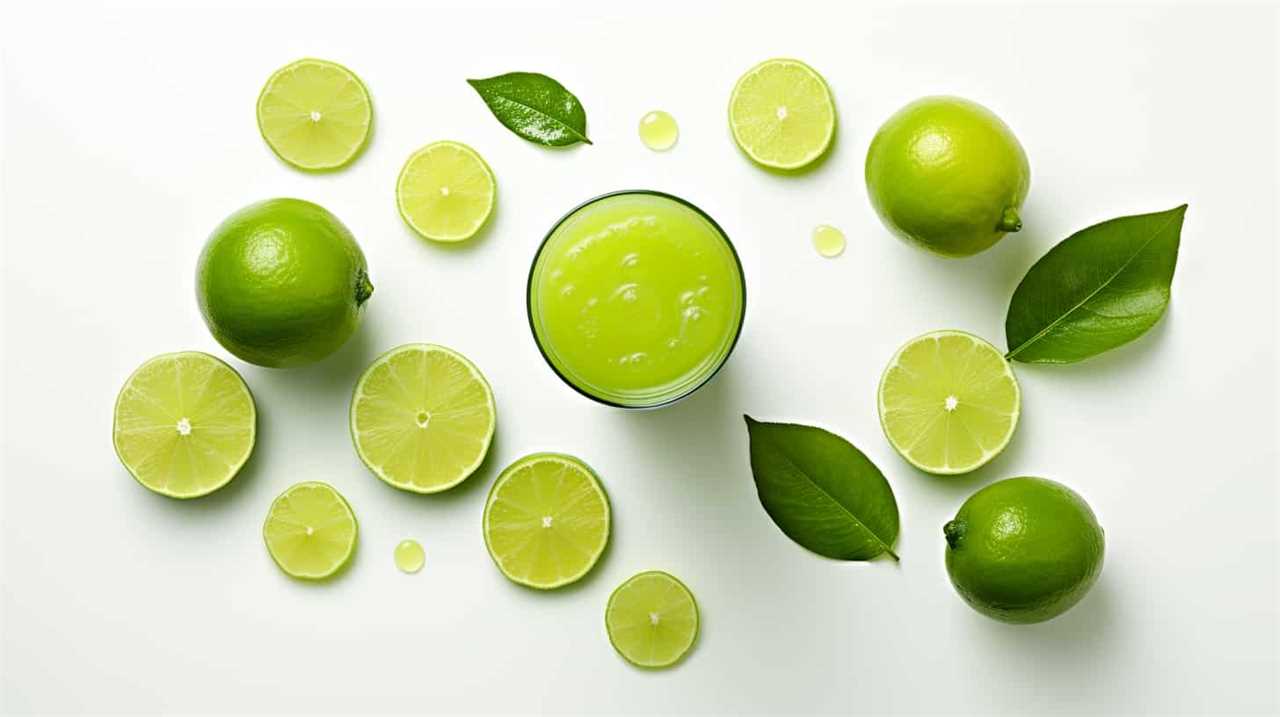
Key Takeaways
- Choose a reputable brand of aloe vera juice that prioritizes quality and uses organic, pure aloe vera.
- Avoid brands that contain added sugars or artificial ingredients.
- Use natural sweeteners like honey, agave syrup, or stevia to enhance the taste of aloe vera juice.
- Experiment with adding fruits, herbs, and other juices to create unique flavor combinations and enhance the health benefits of aloe vera juice.
Choosing the Right Aloe Vera Juice
We can enhance our experience with aloe vera juice by selecting the right brand and type for our preferences. When it comes to finding a reputable brand, it’s important to do some research and read reviews from other consumers. Look for brands that prioritize quality and use organic, pure aloe vera without any added sugars or artificial ingredients. Understanding the health benefits of aloe vera juice is also crucial in making the right choice. Aloe vera is known for its soothing properties, aiding digestion, promoting skin health, and boosting the immune system. By choosing a high-quality brand, we can ensure that we’re getting the maximum benefits from our aloe vera juice.
Now that we know how to choose the right brand, let’s move on to the next step of adding natural sweeteners.
Adding Natural Sweeteners
To enhance the flavor of our aloe vera juice, we can add natural sweeteners such as honey or agave syrup. Using alternative sweeteners not only adds sweetness but also brings unique flavors to the juice. Here are some options to consider:
- Stevia: A natural sweetener derived from the Stevia plant, it’s a zero-calorie alternative to sugar.
- Maple Syrup: This natural sweetener adds a rich and earthy flavor to the aloe vera juice.
- Dates: Pureed dates can be used to sweeten the juice while also providing essential nutrients like fiber.
In addition to using alternative sweeteners, we can enhance the flavor of aloe vera juice by adding spices and extracts. Cinnamon, ginger, or vanilla extract can add warmth and depth to the taste. By experimenting with different combinations of these natural sweeteners, spices, and extracts, we can create a flavor profile that suits our preferences.
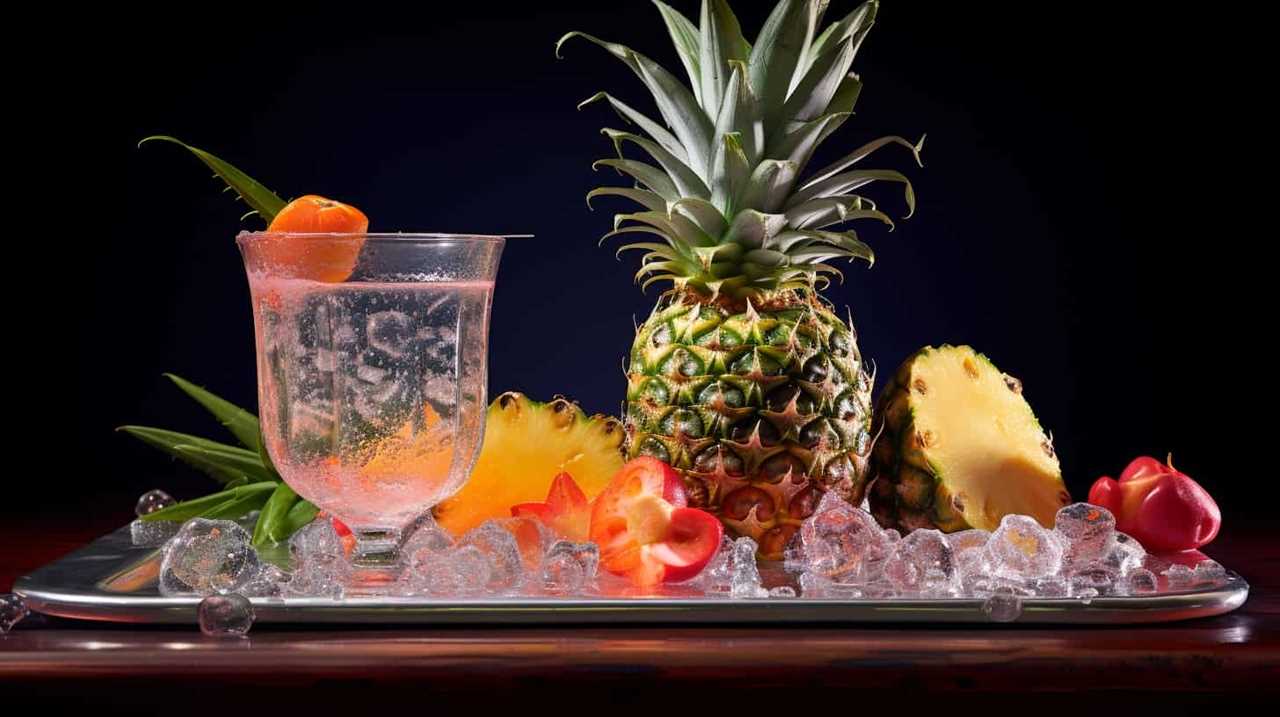
Now, let’s move on to the next section and learn how to infuse aloe vera juice with fruits and herbs to further enhance its taste.
Infusing With Fruits and Herbs
As we explore ways to make our aloe vera juice taste better, one option to consider is infusing it with fruits and herbs. Creating unique aloe vera blends by adding fruits and herbs not only enhances the flavor but also adds a touch of freshness and complexity to the juice. For example, combining aloe vera juice with lemon, mint, or berries can create a refreshing drink that’s both delicious and packed with additional nutrients. It’s similar to the ease of making lemonade with bottled juice—quick, convenient, and customizable to suit your preferences. By experimenting with different fruit and herb combinations, you can elevate your aloe vera juice experience while still reaping its health benefits.
Fruits like strawberries, pineapple, or citrus can add a burst of sweetness, while herbs like mint, basil, or ginger can provide a subtle yet refreshing twist. Exploring the benefits of herbal infusions can also be beneficial for our health. For example, adding a few sprigs of lavender can promote relaxation and reduce stress. Additionally, infusing aloe vera juice with rosemary can aid digestion and boost the immune system.
Blending With Other Juices
Let’s try mixing aloe vera juice with different fruit juices to create delicious and refreshing blends. Blending aloe vera juice with other fruits not only enhances its taste but also adds nutritional benefits to your drink. Here are three fruit juices that you can mix with aloe vera juice:

- Orange juice: Combining aloe vera juice with orange juice not only adds a tangy flavor but also boosts your intake of vitamin C, which is essential for a strong immune system.
- Pineapple juice: Mixing aloe vera juice with pineapple juice creates a tropical blend that isn’t only refreshing but also helps in digestion. Pineapple contains bromelain, an enzyme that aids in breaking down proteins and promoting better digestion.
- Watermelon juice: Blending aloe vera juice with watermelon juice creates a hydrating and refreshing combination. Watermelon is rich in water content and contains electrolytes that can help replenish your body’s fluids.
Experimenting With Flavor Combinations
While we can try various flavor combinations with aloe vera juice, it’s important to find the right balance to enhance its taste. Experimenting with different flavors can’t only make the juice more enjoyable but also enhance its health benefits.
Aloe vera juice is known for its numerous health benefits, such as boosting digestion, promoting hydration, and supporting the immune system. By adding complementary flavors, we can create a refreshing summer drink that not only tastes great but also provides a nutritional boost.
Some popular flavor combinations include mixing aloe vera juice with citrus fruits like lemon or orange, adding a splash of coconut water for a tropical twist, or combining it with cucumber and mint for a refreshing and cooling effect.
Don’t be afraid to get creative and find the flavor combination that suits your taste buds best!
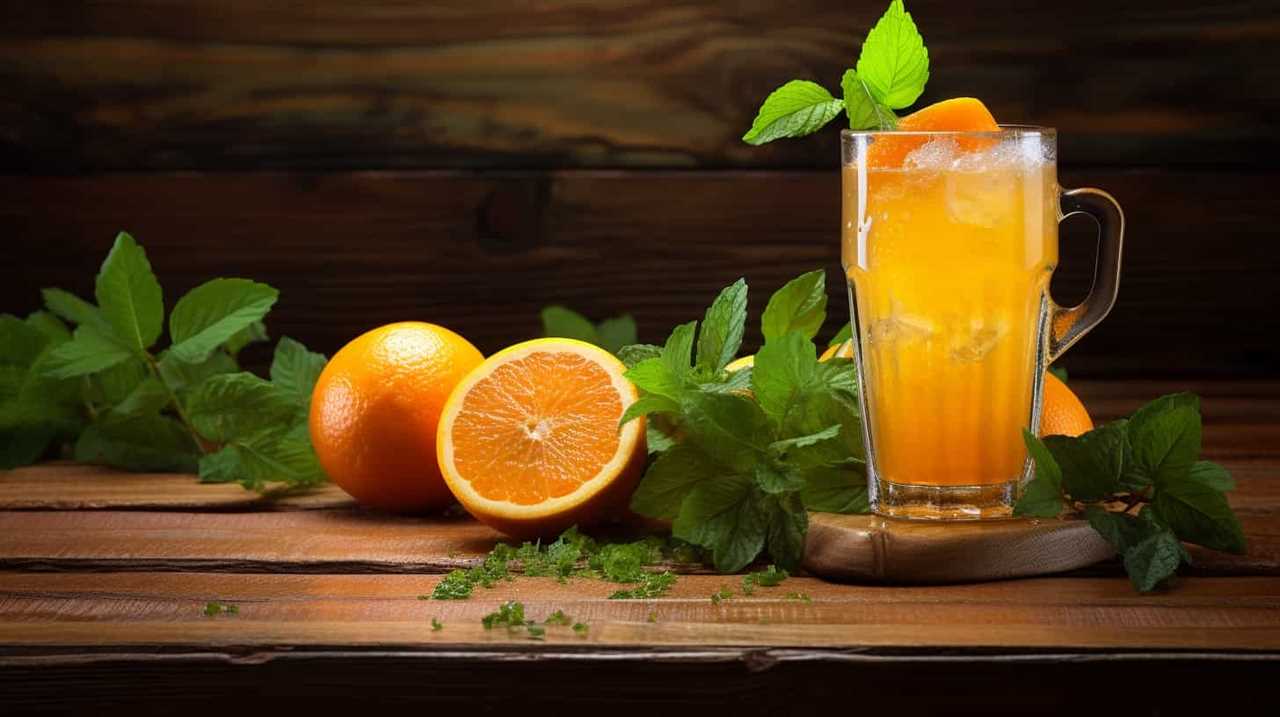
Frequently Asked Questions
Can I Use Store-Bought Aloe Vera Gel Instead of Fresh Aloe Vera for Making Juice?
Yes, you can use store-bought aloe vera gel instead of fresh aloe vera for making juice. However, it’s important to note that fresh aloe vera juice may have more health benefits due to its higher nutrient content.
How Long Can I Store Aloe Vera Juice in the Refrigerator?
Aloe vera juice can be stored in the refrigerator for up to a week. Refrigeration helps maintain the longevity and freshness of the juice, preserving its beneficial properties. It’s important to store the juice in an airtight container to prevent contamination and maintain its quality. Similarly, you might wonder *how long ginger juice lasts*; typically, fresh ginger juice can be refrigerated for about 1–2 weeks as well. Both aloe vera and ginger juices are best consumed within their shelf life to ensure maximum potency and health benefits. Additionally, freezing either juice can extend their shelf life, though some loss of nutrients and potency may occur during the process. When thinking about *how long fresh juice lasts*, it’s crucial to check for signs of spoilage, such as changes in smell, taste, or color, before consuming. To enjoy the best results, it’s always recommended to use fresh ingredients and properly store the juice to ensure you’re getting the most out of its health benefits.
Can Aloe Vera Juice Help With Digestive Issues?
Aloe vera juice can potentially help with digestive issues when taken in appropriate dosages. However, it is important to note that there may be potential side effects. It is always best to consult with a healthcare professional before starting any new supplement regimen.
Can I Use Artificial Sweeteners Instead of Natural Sweeteners in My Aloe Vera Juice?
Using artificial sweeteners in aloe vera juice may affect its taste and potential health benefits. However, natural sweeteners like honey or stevia can enhance the flavor without compromising its nutritional value.

Is It Safe to Drink Aloe Vera Juice Every Day?
Drinking aloe vera juice daily can have numerous benefits, such as improving digestion and boosting the immune system. However, consuming it regularly may also lead to potential side effects like diarrhea or stomach cramps.
Conclusion
In conclusion, making aloe vera juice taste better is easy and enjoyable.
By choosing the right aloe vera juice and adding natural sweeteners, infusing with fruits and herbs, blending with other juices, and experimenting with flavor combinations, you can create a delightful and refreshing drink.
So go ahead and unleash your creativity in the kitchen, and transform your aloe vera juice into a sensational elixir that will transport your taste buds to paradise.
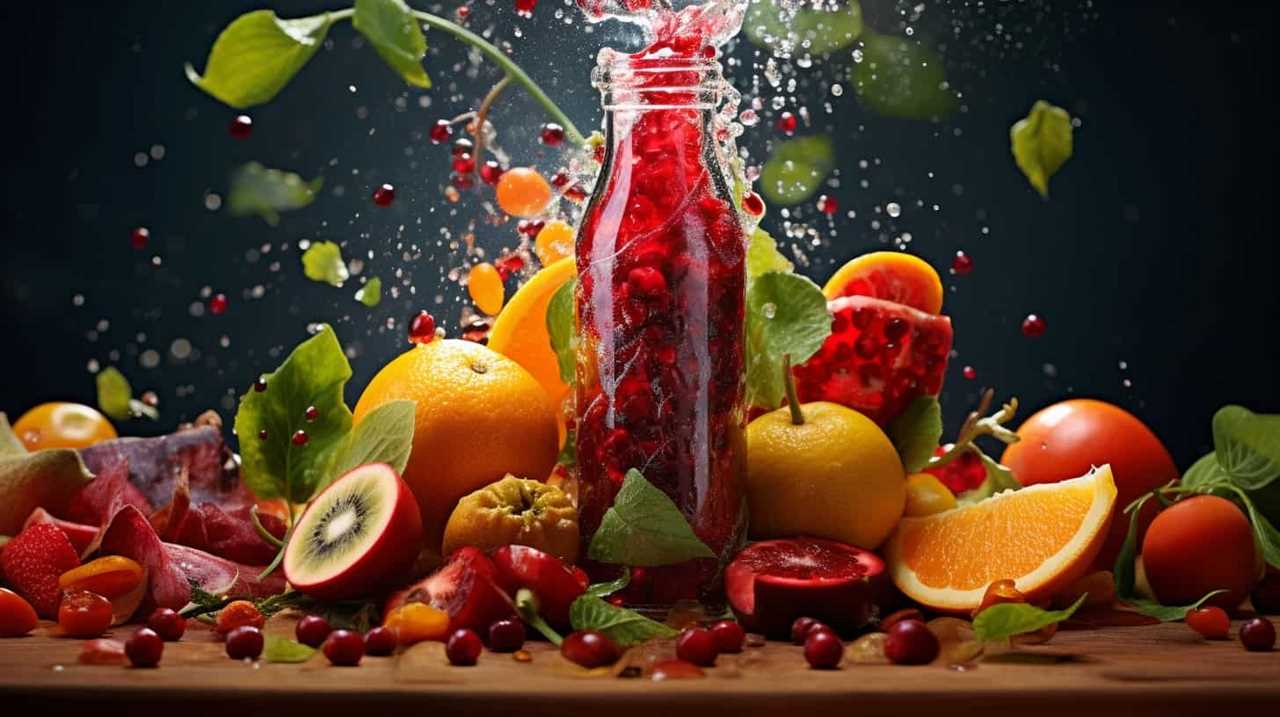
Susannah expertise lies in researching and compiling evidence-based content on juicing, nutrition, and overall health. She is committed to ensuring that The Juicery World offers accurate, up-to-date, and trustworthy information to empower readers to take control of their health. Susannah’s goal is to inspire individuals to embrace juicing as a way to nourish their bodies and live their best lives.
Juice Tips and Tricks
How to Make a Glass of Lemonade With Bottled Lemon Juice

Are you craving a cool glass of lemonade to quench your thirst? Look no further! Try out our perfect recipe using bottled lemon juice that will surely please your taste buds.
In this article, we’ll guide you through the process of creating a tangy and sweet concoction that will leave you feeling refreshed and satisfied.
So grab your ingredients and let’s get started on this delightful journey of serving ourselves and others a glass of pure lemony goodness.
Key Takeaways
- Consider the storage of the bottled lemon juice (dark glass or plastic bottles, protect from light exposure, check expiration date)
- Choose a suitable pitcher and fresh lemons for enhanced flavor
- Store the lemonade concentrate in the refrigerator to maintain freshness
- Adjust the sweetness and tartness to taste with sugar or more lemon juice, and experiment with different sweeteners or additional flavors.
Choosing the Right Bottled Lemon Juice
What are the key factors we should consider when selecting the right bottled lemon juice for our lemonade?

One important factor is how the lemon juice is stored. Look for bottles that are made of dark glass or plastic, as they help protect the juice from light exposure, which can degrade its quality. It’s also important to check the expiration date to ensure freshness.
Another benefit of using bottled lemon juice is convenience. It saves time and effort compared to squeezing fresh lemons. Additionally, bottled lemon juice provides consistent flavor, as the acidity levels are standardized.
When selecting a brand, consider reading reviews and checking for certifications, such as organic or non-GMO.
Gathering the Necessary Ingredients and Tools
How can we gather all the necessary ingredients and tools to make a glass of lemonade with bottled lemon juice? First, we’ll need to collect bottled lemon juice, sugar, and cold water, as well as a pitcher and a spoon for mixing. If you prefer extra flavor, you can also gather ice and optional add-ins like mint or soda water. While preparing the lemonade, it’s easy to understand why some people wonder about other citrus drinks and may ask, “how many oranges per gallon” are needed when making orange juice instead. Once everything is assembled, combine the lemon juice, sugar, and water in the pitcher, stirring until the sugar dissolves. Feel free to adjust the sweetness or tartness to your liking, and don’t forget to add ice or any optional add-ins for an extra refreshing touch. This process might even make you curious about how much juice from oranges is needed when making fresh orange juice compared to using bottled citrus products. Once your lemonade is ready, pour it into a glass and enjoy the refreshing taste. This simple recipe can inspire you to try other homemade juices, such as learning **how to make pear juice** or experimenting with other fruit combinations. Whether you’re using fresh fruits or bottled options, creating your own beverages is a fun and rewarding way to personalize your drinks.
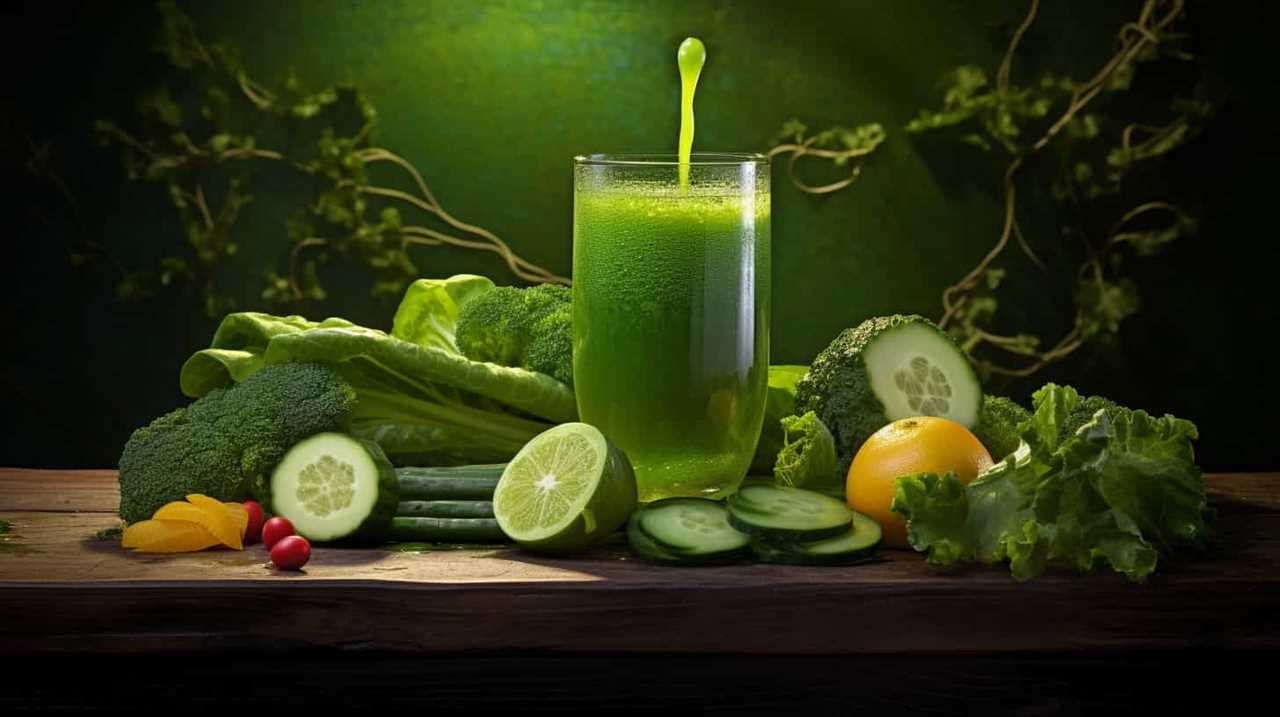
It’s important to start with the right pitcher. Look for a pitcher that’s made of glass or BPA-free plastic, as these materials won’t affect the taste of the lemonade. The pitcher should also have a lid or cover to keep the lemonade fresh and prevent spills.
Now, let’s talk about the lemons. While bottled lemon juice is convenient, using fresh lemons instead can elevate the flavor of your lemonade. Choose lemons that are firm and have a bright yellow color. Give them a gentle squeeze to ensure they’re juicy. To extract the juice, you’ll need a citrus juicer or a reamer. These tools make it easy to get every last drop of juice from the lemons.
Mixing the Lemonade Concentrate
To start mixing the lemonade concentrate, we’ll slowly pour the bottled lemon juice into the pitcher. It’s important to choose the right container for the lemonade concentrate. A pitcher with a lid or a tightly sealed container will help maintain the freshness and prevent any spills or leaks. Once the lemon juice is in the pitcher, we can move on to the next step of adding water and sweetener.
To ensure the lemonade concentrate stays fresh, it’s essential to store it properly. Keep the pitcher in the refrigerator to maintain its cool temperature and prevent any bacteria growth. If you have any leftover concentrate, transfer it to a smaller container with an airtight lid before refrigerating. This will help retain its flavor and prevent any contamination.

Now that we’ve mixed the lemonade concentrate, it’s time to adjust the sweetness and tartness to taste.
Adjusting the Sweetness and Tartness to Taste
We can adjust the sweetness and tartness of the lemonade to taste by adding more sugar or lemon juice, respectively. If you prefer a sweeter lemonade, simply add more sugar and stir until it dissolves completely. You can experiment with different sweeteners such as honey or agave syrup to find the perfect balance of sweetness.
On the other hand, if you want a tangier lemonade, add more lemon juice gradually, tasting as you go until it reaches your desired level of tartness.
Additionally, you can get creative with your lemonade by adding flavors like fresh mint leaves or a hint of lavender. These additions can elevate the flavor profile and create a more refreshing and unique experience.

Now that we’ve adjusted the sweetness and tartness of our lemonade, let’s move on to serving and enjoying your refreshing glass of lemonade.
Serving and Enjoying Your Refreshing Glass of Lemonade
Now let’s sit back, relax, and savor our refreshing glass of lemonade.
When it comes to serving and enjoying this delightful drink, there are a few techniques and garnishing options to consider.
Firstly, serving your lemonade chilled is essential for maximum enjoyment. Ensure that you have chilled glasses or add ice cubes to the glasses before pouring the lemonade.

To add a touch of elegance, you can garnish your lemonade with a slice of lemon on the rim of the glass. For an extra burst of flavor, you could also add a sprig of fresh mint or a few berries.
Remember to gently stir the lemonade before serving to evenly distribute the flavors.
Now, take a sip, feel the refreshing tang of lemon, and let the sweet and tart flavors dance on your taste buds.
Cheers!

Frequently Asked Questions
Can I Use Fresh Lemons Instead of Bottled Lemon Juice?
Fresh lemons offer numerous benefits over bottled lemon juice. The taste of fresh lemons is unparalleled, providing a vibrant and tangy flavor. Incorporating fresh lemons into your lemonade will elevate its taste and give it a refreshing and authentic twist.
Can I Substitute Sugar With a Different Sweetener?
Substituting sweeteners in lemonade can enhance the flavor and offer health benefits. We’re knowledgeable about alternative sweeteners and can provide precise, detailed instructions on using them in place of sugar.
How Long Does the Lemonade Concentrate Need to Chill in the Refrigerator?
The chilling time for the lemonade concentrate in the refrigerator is typically around 1-2 hours. Using bottled lemon juice offers the benefit of convenience and consistent flavor for a refreshing glass of lemonade.
Can I Add Other Fruits or Flavors to the Lemonade?
Sure, we can definitely add different fruits or flavors to our lemonade. It’s a great way to experiment with unique flavors and create refreshing, personalized drinks. The possibilities are endless!

How Long Does the Lemonade Stay Fresh in the Refrigerator?
Lemonade made with bottled lemon juice can stay fresh in the refrigerator for about 5-7 days. To maximize shelf life, store it in an airtight container and keep it chilled.
Conclusion
And so, with a few simple steps and the right ingredients, a glass of refreshing lemonade is born.
Like a symphony of flavors dancing on your taste buds, this tangy elixir quenches thirst and brings joy on a hot summer day.
Just a sip transports you to a world of citrusy delight, where the sweetness and tartness blend harmoniously.

So go ahead, indulge in the art of lemonade-making and savor every drop of this sun-kissed nectar.
Cheers to the perfect glass of lemonade!
Susannah expertise lies in researching and compiling evidence-based content on juicing, nutrition, and overall health. She is committed to ensuring that The Juicery World offers accurate, up-to-date, and trustworthy information to empower readers to take control of their health. Susannah’s goal is to inspire individuals to embrace juicing as a way to nourish their bodies and live their best lives.
Juice Tips and Tricks
How to Know if Orange Juice Is Bad

We’ve all been in that situation before – reaching for a glass of orange juice and hesitating, unsure if it’s still okay to drink. Fear not! This article will give you the knowledge you need to determine for sure if your orange juice is still fresh or if it’s gone bad.
With a blend of scientific precision and practical tips, we’ll explore color changes, strange smells, off taste, texture changes, and mold or growth that may indicate spoilage.
Let’s dive in and serve ourselves a refreshing glass of certainty!
Key Takeaways
- Color changes in orange juice can indicate a loss of freshness and shelf life extension, but it doesn’t necessarily mean the juice is bad.
- Unusual or off-putting odors in orange juice, such as sour or fermented scents, can be a sign of poor quality.
- An off taste in orange juice, such as sour, bitter, or fermented flavors, suggests that the juice is spoiled.
- Texture changes in orange juice, such as pulp separation or a thicker consistency, can occur as the juice ages, so it’s important to consume it before the expiration date.
Color Changes in Orange Juice
We should be aware that color changes can indicate whether orange juice is bad.

When it comes to orange juice, color is a crucial factor to consider. As oranges are exposed to air, an oxidation process occurs, which leads to changes in color. Fresh orange juice has a vibrant orange hue, indicating its freshness and high nutritional value.
However, as time passes, the juice may undergo a color change, turning dull or brownish. This change in color is a result of the oxidation process, which affects the flavor and quality of the juice. It’s important to note that while a change in color doesn’t necessarily mean the juice is bad, it does indicate that the juice is losing its freshness and shelf life extension.
Therefore, it’s advisable to consume orange juice when it’s at its freshest, as indicated by its vibrant orange color.
Strange Smells in Orange Juice
When it comes to evaluating orange juice, we should be cautious of any strange smells or odors. A fresh, pleasant smell is indicative of good quality orange juice. However, if you notice any unusual or off-putting odors, it may be a sign that the juice has gone bad. These smells can range from a sour or fermented scent to a rancid or moldy aroma.

It’s important to note that while some natural variations in scent can occur due to the specific variety of oranges used, any strong or unpleasant smells should raise concerns. If you have citrus fruit allergies, it’s especially important to pay attention to the smell of orange juice, as it could indicate the presence of spoilage or contamination.
Ensuring the quality of orange juice is essential as it’s a popular beverage known for its health benefits, including being rich in vitamin C and antioxidants.
Off Taste of Orange Juice
Our taste buds can detect even the slightest hint of an off taste in orange juice, which can indicate that it has gone bad. The taste of orange juice should be fresh, tangy, and slightly sweet. If it tastes sour, bitter, or fermented, it’s likely spoiled.
One common cause of an off taste in orange juice is the use of overripe oranges. When oranges become overripe, their flavor profile changes, resulting in a less pleasant taste. Another factor to consider is the expiration date. Orange juice that has passed its expiration date is more likely to develop an off taste. It’s important to check the expiration date before consuming orange juice to ensure its freshness and quality. Additionally, improper storage conditions, such as leaving the juice at room temperature for extended periods, can lead to the development of unpleasant flavors. Storing orange juice in the refrigerator helps maintain its freshness for longer. For those exploring different juice options, aloe vera juice flavor tips suggest pairing tart juices with milder flavors to balance the overall taste.
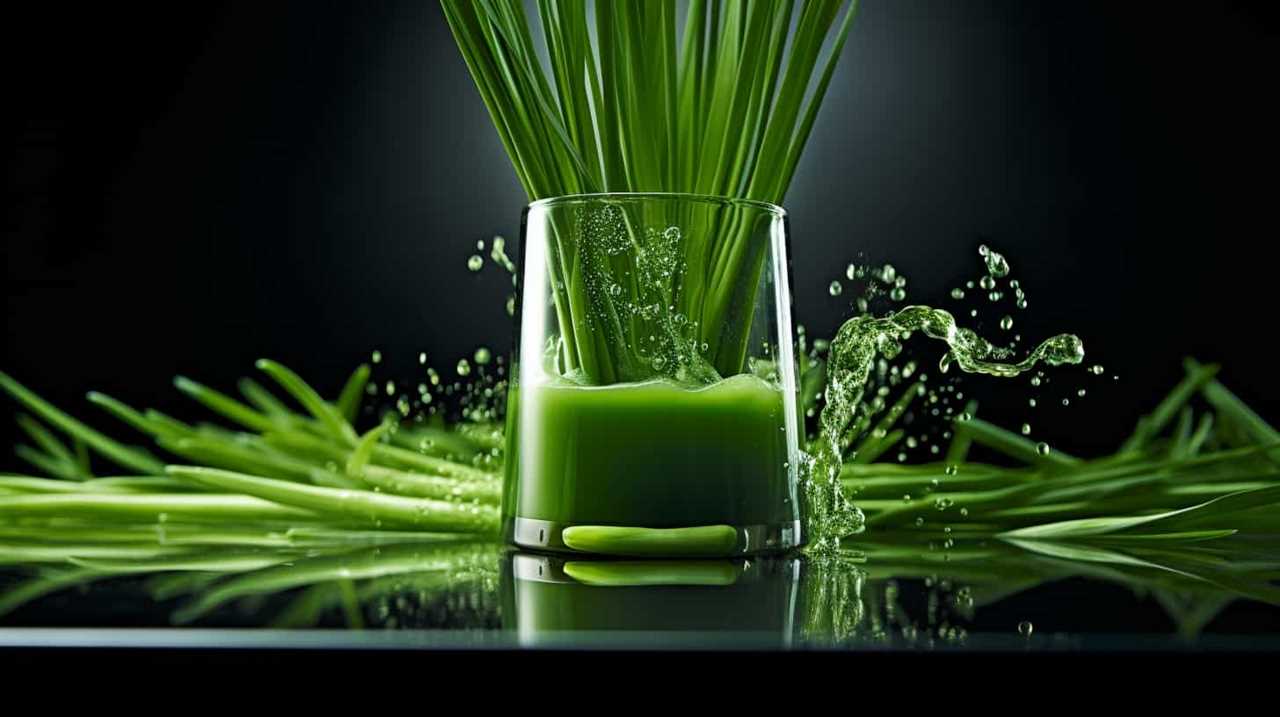
Now, let’s move on to discuss the texture changes in orange juice.
Texture Changes in Orange Juice
As we explore the texture changes in orange juice, it’s important to note that certain factors can cause it to become thicker or develop sediment. One common texture change in orange juice is pulp separation, where the pulp separates from the liquid and settles at the bottom. This can occur naturally over time, as the pulp particles become denser and sink.
Another factor that can affect the texture of orange juice is the expiration date. As orange juice ages, it may start to develop a thicker consistency and even form sediment. This is a result of the natural breakdown of the juice’s components. Therefore, it’s crucial to check the expiration date on orange juice and consume it before it reaches its expiration date to avoid any undesirable texture changes.
Mold or Growth in Orange Juice
We need to be aware of the possibility of mold or other growth occurring in orange juice. Mold can develop in orange juice if it isn’t stored properly or if it has passed its expiration date.

To prevent mold growth, it’s important to follow these steps:
- Store orange juice in the refrigerator at a temperature below 40°F (4°C).
- Check the expiration date on the bottle before consuming. Discard any orange juice that has expired.
- Keep the container tightly sealed to prevent air and moisture from entering, as these can promote mold growth.
Regularly inspecting orange juice for any signs of mold or unusual growth is essential. If you notice any discoloration, a strange odor, or visible mold, it’s best to discard the juice to avoid any potential health risks.
Frequently Asked Questions
Can Orange Juice Go Bad if It’s Stored in the Freezer for Too Long?
Frozen orange juice can potentially lose its nutrients and change its taste if stored in the freezer for too long. It is important to check for signs of spoilage before consuming it.
How Long Can Orange Juice Stay Fresh in the Refrigerator Once It’s Opened?
Once opened, orange juice can stay fresh in the refrigerator for about 7-10 days. To maintain its freshness, store it properly by keeping it tightly sealed and at a consistently cold temperature. If the orange juice develops an off odor, flavor, or appearance, it’s best to discard it to avoid any potential health risks. Factors like exposure to air and varying temperatures can influence how long orange juice lasts, so it’s crucial to handle it with care. Always check the expiration date as a general guide, but remember that proper storage can extend its freshness slightly. Additionally, avoid leaving the orange juice out at room temperature for extended periods, as this can significantly shorten how long orange juice lasts. Freezing the juice can be another option to extend its shelf life, but be aware that this may alter its texture and taste once thawed. By following these precautions, you can ensure your orange juice stays fresh and safe to consume.
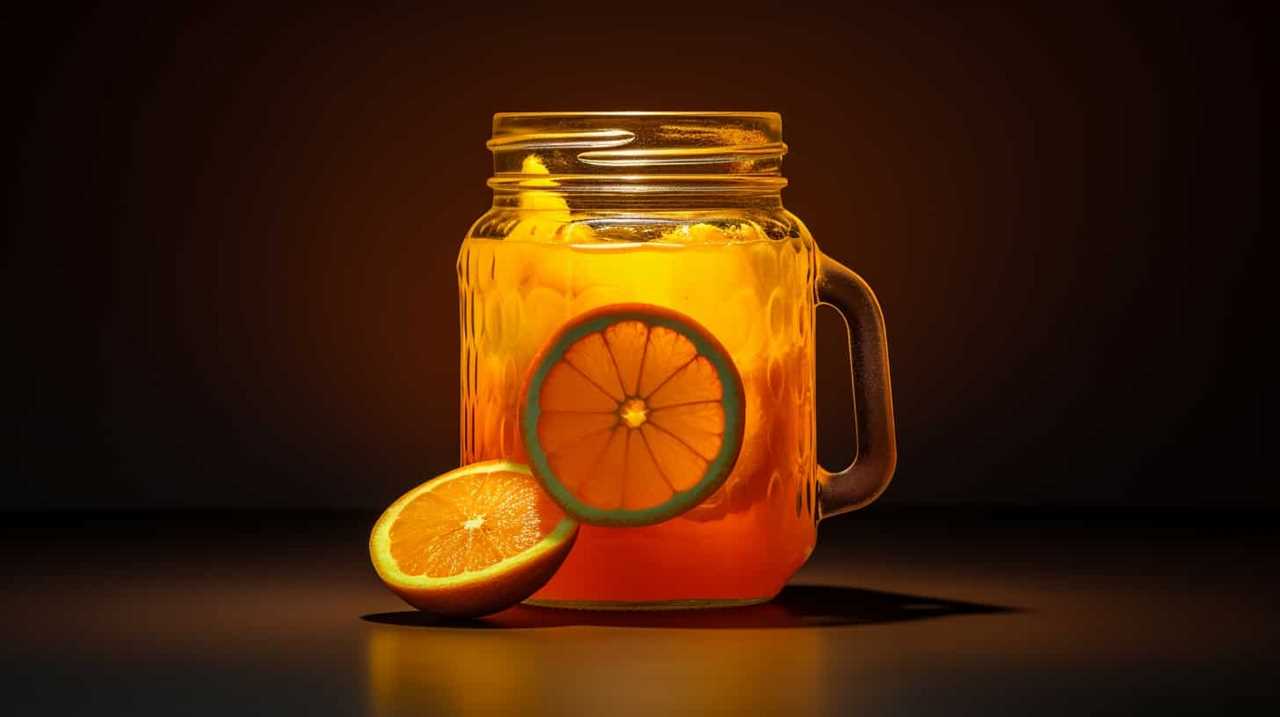
Is It Safe to Consume Orange Juice That Has Been Left Out at Room Temperature Overnight?
Left out orange juice may not be safe to drink as it can harbor harmful bacteria. Signs of spoiled orange juice include a sour smell, mold growth, and a change in color or taste.
Can Orange Juice Develop Harmful Bacteria if It’s Past Its Expiration Date but Still Looks and Smells Fine?
Orange juice can cause food poisoning if it develops harmful bacteria, even if it looks and smells fine. Signs of spoiled orange juice include a sour smell, mold growth, and a change in color or taste.
Does the Nutritional Value of Orange Juice Decrease as It Starts to Go Bad?
As orange juice goes bad, its nutritional value decreases. The longer it sits on the shelf, the more nutrients it loses. Signs of spoilage include a sour smell, off taste, and mold growth.
Conclusion
In conclusion, determining if orange juice is bad requires careful observation of color changes, strange smells, off taste, and texture changes. Just like a detective investigating a case, we must rely on our senses to detect any signs of spoilage.
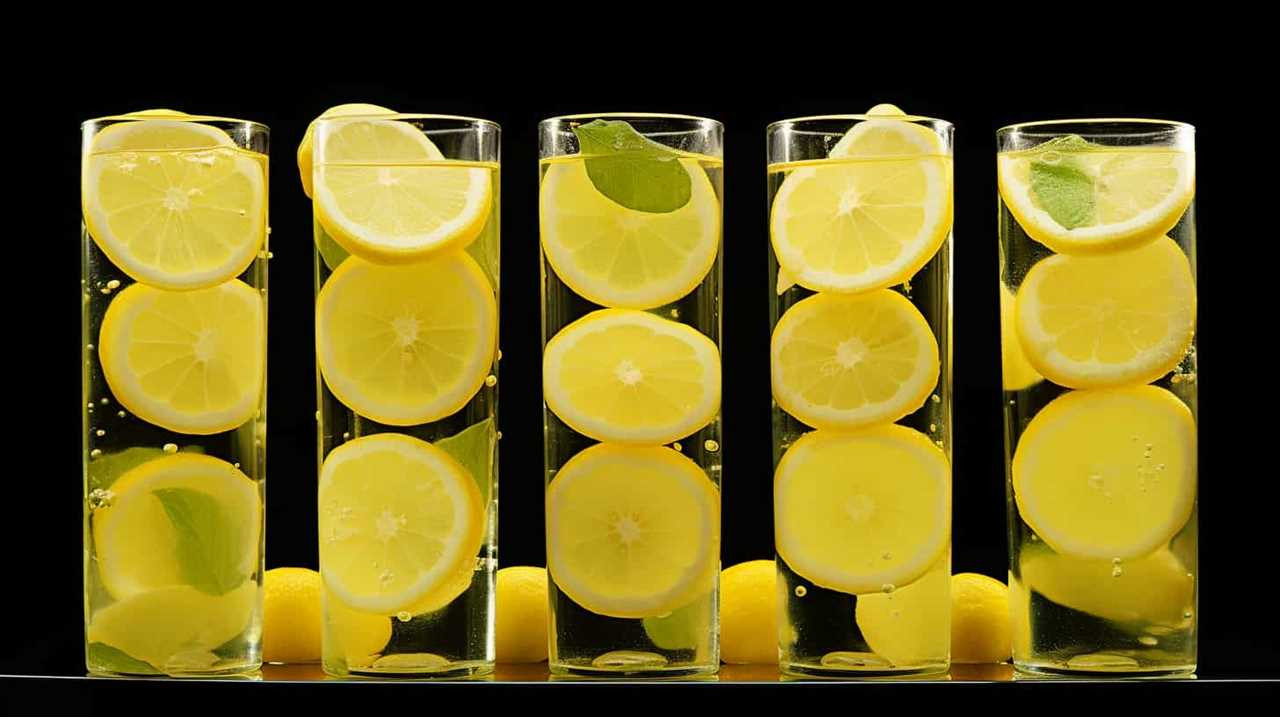
If we detect mold or growth in the orange juice, it’s a clear indication that it’s no longer safe to consume. By remaining vigilant and attuned to these indicators, we can ensure that our orange juice is always fresh and enjoyable.
Susannah expertise lies in researching and compiling evidence-based content on juicing, nutrition, and overall health. She is committed to ensuring that The Juicery World offers accurate, up-to-date, and trustworthy information to empower readers to take control of their health. Susannah’s goal is to inspire individuals to embrace juicing as a way to nourish their bodies and live their best lives.
-

 Vetted2 months ago
Vetted2 months ago15 Best Juices for Diabetics: Refreshing Options That Won’t Spike Your Blood Sugar
-

 Vetted2 months ago
Vetted2 months ago15 Best Decaf Coffee Options for Flavor Lovers Who Need a Caffeine Break
-

 Vetted2 months ago
Vetted2 months ago15 Best Espresso Ground Coffees to Elevate Your Morning Brew
-

 Vetted2 months ago
Vetted2 months ago15 Best K-Cup Coffee Pods for a Perfect Brew Every Time
-

 Vetted2 months ago
Vetted2 months ago15 Best Beans for Espresso: A Guide to Perfecting Your Brew
-

 Vetted2 months ago
Vetted2 months ago15 Best Inexpensive Espresso Machines That Brew Quality Coffee on a Budget
-

 Vetted2 months ago
Vetted2 months ago15 Best Cold Brew Coffees to Keep You Refreshed All Summer Long
-

 Vetted2 months ago
Vetted2 months ago15 Best Kona Coffees to Savor the Rich Flavors of Hawaii




